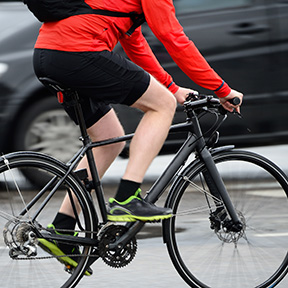Cyclists, be road wise: Traffic laws protect all roadway users
Act like a vehicle.
- Ride on streets, roadways, and bike paths and routes – not on sidewalks.
- Travel with traffic, not against it.
- Stop at all red lights and stop signs.
- Use hand signals when turning, stopping, or slowing.
- Yield to pedestrians.
Stay to the right (usually).
Ride about 3 feet from the right curb or roadway edge, unless you have to move into the main lane to avoid a hazard. If you do need to “take the lane,” signal first, then yield with caution.
Side by side?
- You can ride next to another bicycle, as long as you do not block traffic.
- 3 or more bikes across is not allowed, except on a bike-only route.
Be bright, use lights!
 When riding at night, your bike must have:
When riding at night, your bike must have:
- A front headlamp (white light) that can be seen from 500 feet away.
- A rear red reflector (visible from 300 ft) or red lamp (visible from 500 ft).
Motorists, be bike wise: Traffic laws protect all roadway users
The Share the Road message encourages safety and awareness by all road users – motorists, motorcyclists, pedestrians, and bicyclists. Motorists and bicyclists share the same road, and both have equal rights and responsibilities to know and obey all traffic laws, respect others, and be safe.
Remember to always:
- Pass cyclists with care. Be patient and wait until it is safe to pass just as with other slow-moving vehicles.
- Give them plenty of room. Allow at least 3 feet between your vehicle and the bicycle when passing.
- Bicyclists are required to ride as far to the right as practicable. But they can legally use the travel lane when:
- Overtaking and passing another vehicle proceeding in the same direction.
- Preparing for a left turn while at an intersection or onto a driveway.
- Avoiding unsafe conditions, such as parked vehicles, pedestrians, potholes, debris, etc.
- Never drive in a bike lane. Those lanes are specifically for cyclists to enhance their safe.
- Use turn signals when changing lanes or turning. Be predictable.
- Understand which vehicle has the right of way. Allow bicyclists their turn.
- Pedestrians always have the right of way.
A bicycle is a vehicle.
- Bicycles can and should ride on streets and roadways, not on sidewalks.
- At intersections, follow the same right-of-way rules that you would with other road users.
- Don’t crowd a cyclist when passing. A good rule of thumb: leave at least 3 feet between your car and the cyclists.
- Don’t “tailgate” a bicycle.
Look for bikes on the right (mostly).
Cyclists mostly ride close to the side of the roadway but can take the full lane when:
- Passing another bicycle.
- Preparing to turn left.
- The right side lane is blocked.
- The travel lane is too narrow for a bicycle and a car to travel side by side.
What’s the law in your city?





Join the Ride!